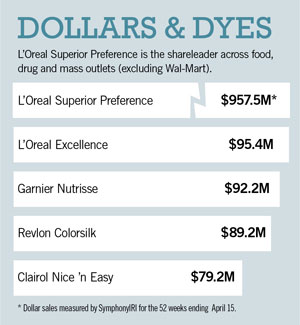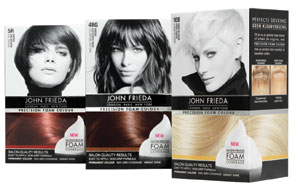Putting your best face forward is not typically meant literally. But for consumers looking to maintain salon-quality coiffure in budget-tightening times, putting your best face forward often means exchanging the salon visits for at-home hair-coloring products.
“Given the current economic conditions, more consumers are looking for more ways to cut back on expenses,” said Benny Smith, spokesman for Food Lion. “Coloring hair at home is a great way to reduce the cost associated with hair maintenance. We offer a variety of shades and the latest coloring technology available on the market today at low prices.”
 In 2011, the at-home hair coloring market was a $1.9 billion industry posting a 3% increase over the previous year, according to Chicago-based Mintel. The growth of the at-home market comes at the expense of the salon industry as consumers tighten their budgets.
In 2011, the at-home hair coloring market was a $1.9 billion industry posting a 3% increase over the previous year, according to Chicago-based Mintel. The growth of the at-home market comes at the expense of the salon industry as consumers tighten their budgets.
The majority of sales growth comes from women — particularly ages 35 to 64 — who are the primary consumers of at-home dyes. SymphonyIRI Group, Chicago, sales data for the 52 weeks ending April 15, puts the market at more than $950 million in sales compared with the men’s segment of just under $150 million.
A Mintel survey finds that one-third of Hispanic respondents use permanent dyes, making them the largest ethnic group to use these products.
These two demographic trends bode well for the hair-coloring category as both the female and Hispanic populations are expected to grow through 2016.
Salisbury, N.C.-based Food Lion uses these and other marketing tools to match the products it stocks to its customers’ needs.
“We leverage a variety of tools such as customer insights and market data to ensure our company is merchandising the correct hair-shading products and technology to our customers,” said Smith.
Maria Brous, spokeswoman for Lakeland, Fla.-based Publix Super Markets confirmed that the chain has seen hair color sales grow over the past two years.
“The majority of change within the past year can be attributed to three brands: John Frieda, L’Oreal and Nice ’n Easy,” she said.
Data tracked by SymphonyIRI show that the same top-performing brands at Publix also sell well at other supermarkets, drug stores and mass merchandisers (excluding Wal-Mart). L’Oreal Superior Preference, which claims to defy fade-out for up to 8 weeks, is the shareleader of the combined channels with $117 million in sales, followed by L’Oreal Excellence Women’s Hair Coloring ($95.4 million) and Garnier Nutrisse Women’s Hair Coloring ($92.2 million).
Though customers seem brand loyal to familiar products, retailers report hair-coloring innovations have made a sizable dent in the market. “We continue to introduce new items, thus enhancing our product mix, allowing for a better assortment and more technological products,” said Brous of products like foam coloring kits.
 Two at-home hair-coloring products made SymphonyIRI’s nonfood list of the top 10 Rising Stars, or items on track to be among the bestselling new products of 2012. Clairol Nice ’n Easy Color Blend Foam, touting drip-free tones and highlights, and John Frieda Precision Foam Colour (left), for salon-quality results at home, use new foam technology to reduce the mess generally associated with at-home hair dyes.
Two at-home hair-coloring products made SymphonyIRI’s nonfood list of the top 10 Rising Stars, or items on track to be among the bestselling new products of 2012. Clairol Nice ’n Easy Color Blend Foam, touting drip-free tones and highlights, and John Frieda Precision Foam Colour (left), for salon-quality results at home, use new foam technology to reduce the mess generally associated with at-home hair dyes.
Not surprisingly then, retailers report that the new products have helped grow the category.
“We introduced foam products to our stores last year, and it has contributed to our category growth,” said Brous.
Mintel also recognizes the influence of application innovations, which companies are using to compete for customers in the increasingly crowded market. Besides the foam technology, sprays and sticks for root touch-ups are making an appearance.
Permanent hair dye represents more than half of the at-home hair-coloring market. While semi-permanent products saw 9.3% growth since 2006, the segment’s sales were $352 million or just a third of the permanent segment’s sales, but that shouldn’t prevent retailers from stocking the products.
“We offer a wide variety of products, and focus on the items that our customers buy most such as semi-permanent, demi-permanent and permanent products,” said Food Lion’s Smith.
Colorful Competition
There are two instances when the salon is still a strong competitor against the at-home market, according to Mintel. First, for more complicated color applications — such as highlights — salons remain a desirable alternative to the at-home coloring market. And second, salons remain desirable among the younger 18 to 34 demographic, which lacks confidence of performing a natural-looking application at home.
But supermarkets face marketplace competition from other outlets caused mostly by the limited shelving space allotted to the category. Consumers tend to seek out drug stores for the purchase of their hair-coloring products. With a third of the sales or $627 million, drug stores benefit from stocking a wide selection of products and the most amount of shelf space, according to Mintel.
Total supermarket sales reached $289 million in 2011, up 4.7% from the year prior, with convenience playing a large role. Retailers such as United Supermarkets, Lubbock, Texas, admit they saw category growth without extensive marketing and promotion.
“Although we do not heavily promote this product line, we feel it is still important to make it available as a convenience to our guests to afford them a one-stop-shopping experience,” said United spokesman Eddie Owens.
Other retail channels only saw 1.5% growth from 2006 to 2011. However, outlets on the fringe such as beauty supply stores, which carry higher price point items; mass merchandisers, which carry the affordable brands; and dollar stores remain a competition threat.
Publix and Food Lion haven’t changed the amount of space allotted but instead tend to change the products offered.
“While the hair color space has remained the same, we continue to see performance growth as we best utilize the allotted space with the mix of items and continue to promote product effectively,” said Brous.
Smith said that Food Lion has had a similar experience. “We have not changed the set size and believe we have provided the appropriate space for these products.”
Looking ahead, growth will depend on whether the economy continues to constrain people from visiting salons. Maintaining a stock of diverse products at a variety of price points, including the more affordable ones, will also prevent outlets from losing the customers whose budgets are shrinking the most. Mintel estimates the market will grow by nearly 16% by 2016 and these products will continue to be purchased primarily by women.
By watching these trends, retailers will be able to reach and keep customers. Brous said, “As the economy turned south, many consumers were looking for salon alternatives without heavily sacrificing salon quality. Our focus has been to provide consumers with top-selling, quality product at competitive prices.”




